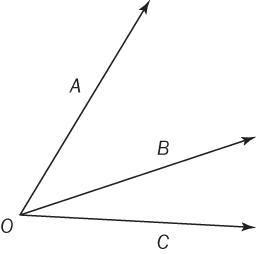Teaching the Common Core Math Standards With Hands-On Activities, Grades 3-5 (46 page)
Read Teaching the Common Core Math Standards With Hands-On Activities, Grades 3-5 Online
Authors: Judith A. Muschla,Gary Robert Muschla,Erin Muschla-Berry
Tags: #Education, #Teaching Methods & Materials, #Mathematics, #General

If two angles are adjacent, the sum of the measures of the two angles is equal to the measure of the large angle that is formed. This is known as the angle addition postulate, which formally states that if is in the interior of
is in the interior of then the
then the (
( is read “the measure of”.)
is read “the measure of”.)

In the example above, and
and are adjacent angles.
are adjacent angles.
If students know the measures of the adjacent angles, they can add the measures to find the measure of the large angle.
If students know the measure of the large angle and the measure of one adjacent angle, they can subtract to find the measure of the other adjacent angle.
Activity: Decomposing Angles
Working in pairs or groups of three, students will decompose three angles in different ways. They will then write an equation to express the sum of the angle measurements. They will also write equations to find missing angle measurements.
Materials
Scissors; protractors; reproducibles, “Angles” and “Angle Instruction Sheet,” for each pair or group of students.
Procedure
1.
Explain that students will decompose (break up into two or more parts) angles into parts that do not overlap.
2.
Distribute copies of reproducible, “Angles,” and explain that it contains eight angles. Each one is named by a small number in the vertex. For example, the first angle is
3.
Instruct your students to cut out the angles along the outside edge of the dark rays and also on the dotted lines.
4.
Provide an example by instructing your students to decomposeinto two angles that they cut out. They should see that
and
can be arranged with no overlaps or gaps to fit in the interior of
To show that this is true, students should measure the angles and write an equation to express the sum.

